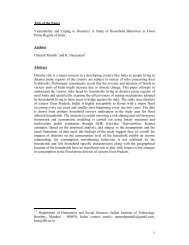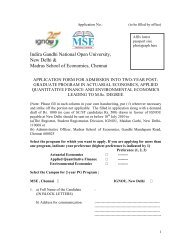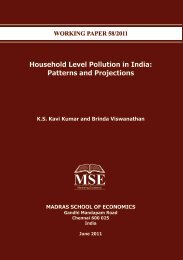A Macro-Fiscal Modeling Framework for Forecasting and Policy ...
A Macro-Fiscal Modeling Framework for Forecasting and Policy ...
A Macro-Fiscal Modeling Framework for Forecasting and Policy ...
Create successful ePaper yourself
Turn your PDF publications into a flip-book with our unique Google optimized e-Paper software.
<strong>for</strong>mulation of the recommendations of the Commission. In particular, the Commission<br />
has been asked as part of ToR the following:<br />
Para 5: “The Commission shall review the state of the finances of the Union <strong>and</strong> the<br />
States, ….., <strong>and</strong> suggest measures <strong>for</strong> maintaining a stable <strong>and</strong> sustainable<br />
environment consistent with equitable growth”.<br />
Para 6 (ii): The dem<strong>and</strong> on the resources of the Central Government, in particular on<br />
account of the projected Gross Budgetary Support….debt servicing <strong>and</strong> other<br />
committed liabilities”.<br />
Para 6 (v): the impact of the proposed Goods <strong>and</strong> Services Tax….including its impact on<br />
the country‟s <strong>for</strong>eign trade. (underlines added)<br />
These issues can be effectively addressed using a macro-econometric modeling<br />
framework prepared <strong>for</strong> <strong>for</strong>ecasting <strong>and</strong> simulations after taking into account the relevant<br />
interrelations among key real, fiscal, trade, <strong>and</strong> monetary aggregates <strong>and</strong> ensuring that<br />
the relevant definitions <strong>and</strong> identities are satisfied. <strong>Macro</strong>economic model, because of its<br />
capacity to capture complex <strong>and</strong> dynamic interrelationships among economic variables, is<br />
a powerful analytical tool that can be useful <strong>for</strong> studying issues of fiscal transfers,<br />
particularly as projections <strong>for</strong> five years are an integral part of the institutional<br />
framework of determining transfers under the aegis of the Finance Commission. It is<br />
useful <strong>for</strong> addressing issues of determining sustainable levels of public debt <strong>and</strong> fiscal<br />
deficit, monetization of deficit, impact of globalization of the Indian economy, <strong>and</strong> the<br />
economy‟s growth prospects in the medium term.<br />
In contrast with other major federations where the exercises <strong>for</strong> determining<br />
vertical <strong>and</strong> horizontal transfers are undertaken contemporaneously or effectively<br />
contemporaneously, the Finance Commissions in India must <strong>for</strong>ecast because the<br />
recommendations period extends to five years <strong>and</strong> the Commission must use available<br />
in<strong>for</strong>mation, which under the best of circumstances may be seven to eight years prior to<br />
the final year of the recommendation. Critical variables that must be <strong>for</strong>ecasted are the<br />
magnitude of central tax revenues <strong>and</strong> own tax revenues of the states, the committed<br />
expenditures in the <strong>for</strong>m of interest payments, levels of other revenue expenditures <strong>and</strong><br />
any desired policy interventions to uplift st<strong>and</strong>ards of selected services like health <strong>and</strong><br />
education.<br />
Other major federations undertake fiscal transfer exercises in a manner that the<br />
need <strong>for</strong> <strong>for</strong>ecasting fiscal aggregates can be avoided. For example, in Australia the<br />
2



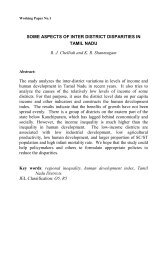

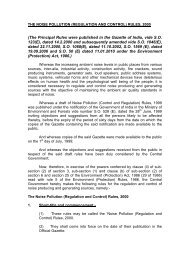
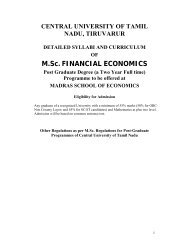
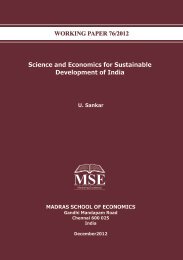
![Curriculum Vitae [pdf] - Madras School of Economics](https://img.yumpu.com/49878970/1/190x245/curriculum-vitae-pdf-madras-school-of-economics.jpg?quality=85)
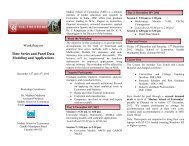
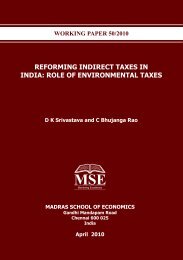
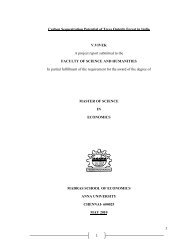
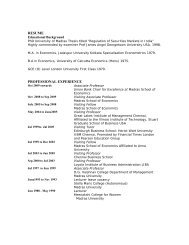
![Curriculum Vitae [pdf] - Madras School of Economics](https://img.yumpu.com/48715201/1/184x260/curriculum-vitae-pdf-madras-school-of-economics.jpg?quality=85)
